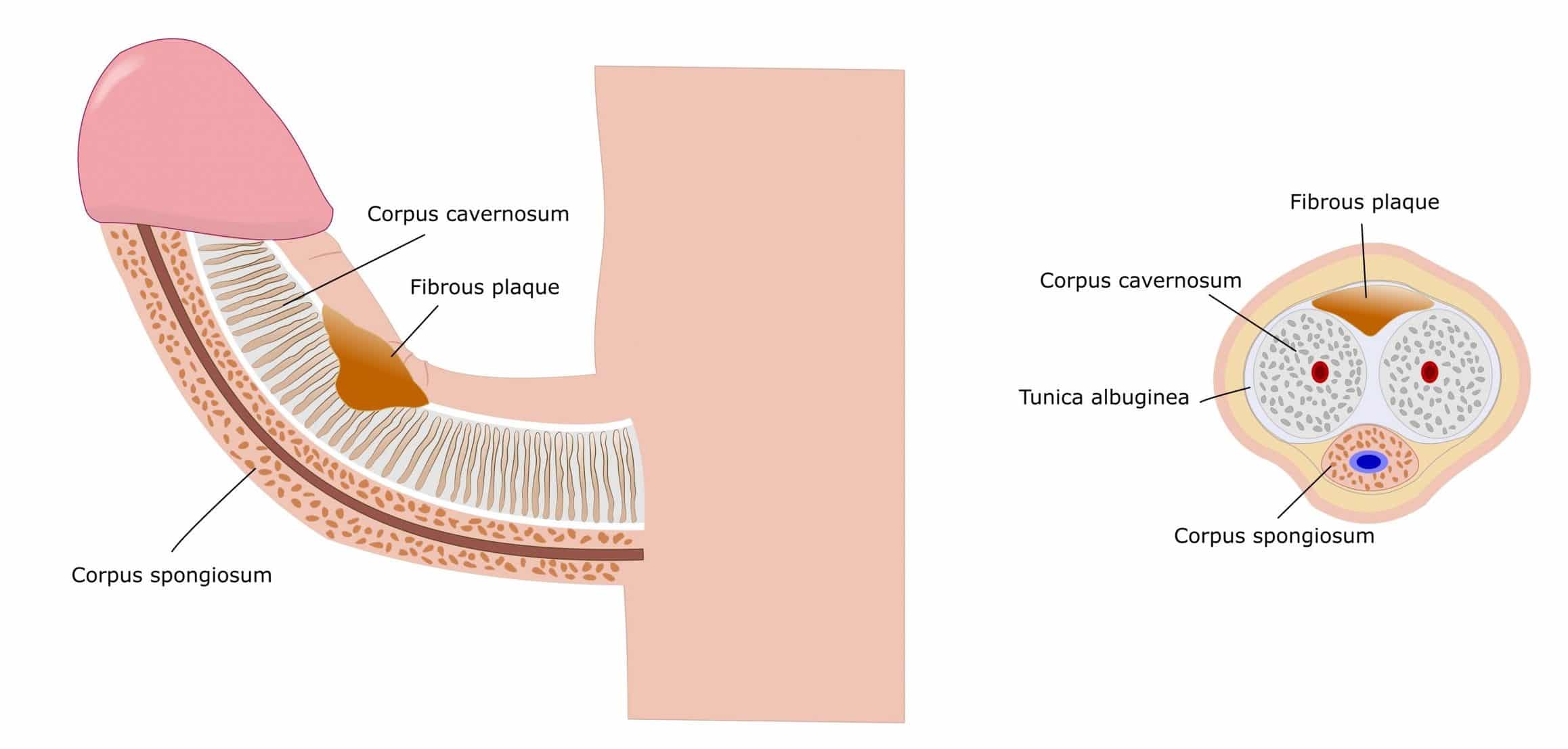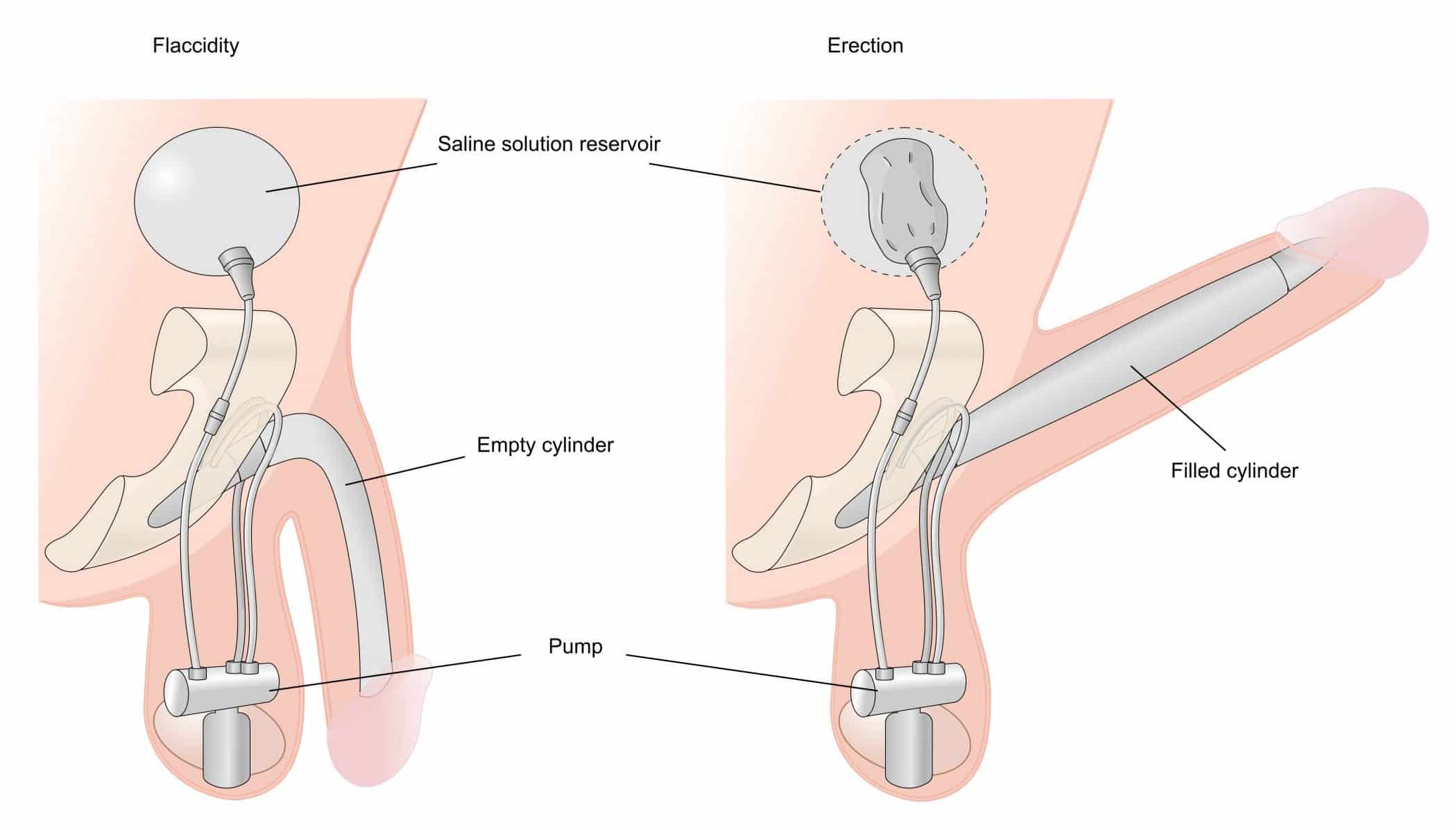Introduction
Peyronie’s Disease (PD) is a condition characterised by an acquired curvature of the penis due to fibrosis of the tunica albuginea.
PD is most prevalent in middle aged men but can affect men of any age and approximately 1 in 16 men are known to affected by PD. PD is generally a progressive condition, with 30-50% of men with the condition experiencing deterioration over time.
PD can be classified into three groups:
- Asymptomatic that does not limit sexual function
- Moderate to severe curvature, causing pain or impeding sexual function
- Erectile dysfunction

Figure 1 – A cross-section of a penis, showing the tunica albuginea
Pathophysiology
The development of the condition can be divided into an acute inflammatory phase followed by a chronic stable phase.
In the acute phase, often minor trauma causes the release of pro-inflammatory cytokines leading to acute inflammation of the tissue, however a fibrotic healing process occurs instead, There is an overproduction of collagen, disrupting the normal tissue architecture of the penis.
Fibrotic plaques are develop at dorsum of the penis and restrict the capacity for the penis to stretch during erections, causing painful shortening and curvature. This can limit or prevent sexual intercourse; the scarring of the erectile tissue can reduce blood flow to the penis leading to erectile dysfunction.
Risk Factors
Main risk factors for the condition include increasing age, diabetes mellitus, ischaemic heart disease, hypertension, and certain medications (beta blockers, proton pump inhibitors, antidepressants and antihistamines)
There is an association between PD and those who suffer from Dupuytren’s contracture, however a genetic link is yet to be identified.
Clinical Features
Patients will present with a significant curvature and shortening of the penis (in severe cases, termed a hinge deformity). In severe cases, patients also suffer with erectile dysfunction. The aesthetic and functional impact of this disease can have significant psychological burden.
In the acute phase of the condition, patients will report a painful erection; this pain typically resolves within 12-18 months in most cases (90%). In the chronic phase, the curvature becomes stable in the absence of pain.
History forms the vast majority of the diagnosis, however to aid potential surgical management, penile length and angulation should be recored. In chronic cases, plaques can potentially be palpated.
Differential Diagnoses
Differentials include congenital penile curvature (often in a young patient with a lifelong ventral penile curvature without pain or the presence of a plaque), penile fracture, and penile cancer.
Investigations
PD is a mainly a clinical diagnosis and no definitive imaging is required to confirm the diagnosis. However ultrasound imaging can identify plaques in certain cases.
Management
The mainstay of management strategies is to improve and maintain sexual function. Educating patients about the disease and management limitations is important to manage expectations and reduce psychological impact.
Phosphodiesterase-5 (PDE5) inhibitors, such as Sildenafil, can be beneficial by improving both erection quality and reducing pain. Intracavernosal injections of vasoactive medications, such as alprostadil, can also be trialled if refractory to treatment.
Mechanical traction apparatus or vacuum erection pumps can be used in the condition, whereby regular use (approximately twice daily for 3-6 months) can reduce penile curvature, increase flaccid length, and reduce pain.
Surgical
The aim of surgery is to reduce penile curvature to restore functional straightness, however should only be considered in patients in the chronic stable phase. Fortunately, multiple surgical options are available
Tunical plications is the most commonly used procedure, whereby small sections of normal tunica albuginea are resected and sutured on long side, opposite to the plaque, and whilst effective its main risk is that it can cause penile shortening. Alternatively, plaque incision and grafting can used in men with more severe curvature (>60o) and good erectile function, whereby the plaque is excised to release the fibrotic tissue and insertion of graft.
Penile prostheses (Fig. 3) are reserved for those with severe PD, erectile dysfunction, and any degree of curvature when medical management has failed, whereby the abnormal corpora cavernosa is removed and replaced with a prosthesis. Whilst these can be high efficacy, preserving both length and function, their main disadvantages in the risk of device failure.
Complications
Due to impact on sexual function, PD carries a high psychological burden. Even men with mild penile curvature can suffer great emotional distress. It is recommended men are screened for anxiety and depression and considered for referral to psychological services.
Key Points
- Peyronies disease causes penile curvature, painful erections, and potentially erectile dysfunction
- Only those with painful erections or limited sexual function require treatment; men with preserved sex function do not require surgery


